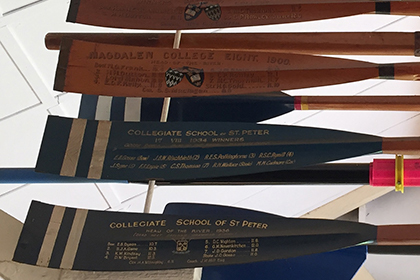Blackmore Club Blog
Recollections and articles from Saints Boat Club

INAUGURAL ROWING MASTER FREDERICK HENRY DIGBY
The introduction of rowing and athletics to St Peter’s owed much to the energy and enthusiasm of a young bachelor-master, Frederick Henry Digby, who served on the staff from 1858 to 1862. Digby had no degree, but he was young, strong and interested in sports. He was probably the driving force behind the formation of the first St Peter’s Rowing Club in 1860. This seems to have been essentially a club for young men who were associated with the School as members of staff, old scholars or sixth formers. Most of the club’s members were old collegians, and membership was restricted to “swimmers only”. The small size of the School and the lack of a permanent Torrens Lake for nearby training until 1881 meant that it was not practicable at this time to race boats wholly crewed by boys still at school. In 1880 the Torrens Weir was built to dam the river and form an ornamental lake. This formed a pleasant body of water and opened up the leisure possibilities for the River Torrens.
The new club first raced a boat, a four-oared gig named “Lady of the Lake”, at the Port Adelaide Regatta on the Port River on New Year’s Day 1861, in the presence of the Governor and Lady MacDonnell, the Chief Justice and Lady Cooper, the Hon. GC Hawker and “several more of the leading colonists”. The “Lady of the Lake” was pitted against another four-oared gig, the “Lady MacDonnell”, entered by the well-established Pelican Club. According to the Register, “The St Peter’s boat took the lead at starting, which it maintained throughout, winning easily by several lengths.” The “Lady of the Lake” was ‘steered by J. Morphett. Pullers – stroke Fred. Digby, B. Featherstone, G. O’Halloran and A. Hallett.’ Morphett was the only member of the crew still at school. B. Featherstone had been in the sixth form from the previous year, G. O’Halloran had been Captain of the School nine years earlier, and A. Hallett had left the School sometime before 1857.
In May 1861 Digby left for England on a year’s leave for family reasons and further education. The School community was undoubtedly sorry to lose him. “The Boys have got a half-holiday in honour of Mr Digby’s departure,” wrote Albinia Short to her sister Millecent, “Mr Digby dined here today & they all went to see him off in the Suffolk.” When later in the year, the School urgently needed a new master, Bishop Short was authorized to write to him offering a rise in salary from 120 to 200 pounds per annum if returned. Digby promptly booked a passage to South Australia and on arrival once more became an enthusiastic member of the St Peter’s College Boat Club.
The Pelican and College Clubs competed again on the afternoon of Saturday 26 April 1862 before a large number of spectators lining the Port River. The College boat, Lady of the Lake, was trailing when she rounded the buoy at the half-way mark, but she pulled ahead to win by a length. The crew then retired to the Port Hotel, and partook in an excellent repast prepared for the occasion.
The Second Eight currently use the Fred. H Digby (pictured below - rowing camp 2019).

Do you have any rowing stories you would like to contribute to The Blackmore Club Blog? If so, we would love to hear from you! Get in contact with us via our email socialmedia@blackmoreclub.com.au